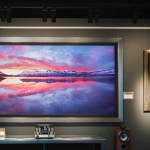Metal Prints vs. Metallic Prints: What Is the Difference?
Whether you need photo printing services for personal, professional, or commercial purposes, you should find the best option. And that means knowledge.
Deciding on a photo print isn’t just about culling your photos and choosing the frame dimensions. It’s also about choosing a printing medium and method. It’s about considering where and how you will exhibit the print, what aesthetic effect you are after, and how the printing process complements the photograph.
If the shiny and modern style appeals to you, consider photo printing services that provide that look. But don’t confuse metal prints and metallic prints, as they are completely different things. And here is why.
Metal Prints vs. Metallic Prints: How Are They Made?
The main difference between metal prints and metallic prints is the printing process.
Firstly, the surface that is being printed (aka the printing medium or substrate) is different. Metal prints have a metal substrate, usually aluminum panels. The printable coating surface may be white like with any other printing service or clear, in which case the whites in the photo are replaced with the silver of the aluminum.
Metallic prints have a high-gloss white paper or canvas substrate with a pearlescent finish that creates a metallic effect. It doesn’t look the same as a metal print, and as we will see later on, the printing medium has a major influence on the photo print’s usability and durability.
Secondly, the printing method differs. Metallic prints use a combination of laminating layers to provide deep blacks, pearlescent, bright whites, and accurate skin tones. They enhance highlights and create a three-dimensional effect. The result is a vibrant, shiny print. However, metallic prints offer a single style. You can’t customize the printing finish.
On the other hand, metal prints have a broader range of finishes. For example, we offer four surface types: white gloss for a smooth glossy finish; white matte for a luxury non-glare finish; silver gloss to bring out the silver of the aluminum and create a real metallic feel; silver matte to make the most of the aluminum surface but without the shine.
There are also three printing techniques available: direct print, face mount, and dye-sublimation. However, the dye-sublimation method is by far the best one, especially for fine-art photo prints. The level of clarity and color vibrancy isn’t met by any of the other two methods. The image is first printed on a special high ink capacity paper and then transferred onto the metal substrate by sublimation (the ink goes from a liquid state to a gas and solidifies on the metal substrate). The result is impressive both in quality and durability. That’s why we use it for our HD Metal Prints, where there’s no room for anything else than perfection of detail, clarity, and impeccable color accuracy.
If you decide on metal prints, we advise you to choose dye-sublimation and ChromaLuxe aluminum panels to achieve the best quality for your photographs. Metal prints offer deep blacks, rich, accurate colors, enhanced details, and a modern three-dimensional look.
Best Photo Types for Metal Prints vs. Metallic Prints
Metal prints and metallic prints produce different effects; thus, each is a better candidate for particular photo types.
Because metal prints with a clear printable coating surface transform whites into silver, they are the perfect candidate for color or black and white photographs of metal structures. For example, industrial photographs of airplanes, cars, or trains look amazing in metal prints with a clear coating because there is a strong connection between the photo’s subject matter and the printing medium. The metal print enriches the industrial aspect of the photographs and provides a deeper understanding of the concept. The same applies to photographs of bridges, steel and glass buildings, or silver objects. And if you add a dark background, you have the perfect metal print.
Photo by Annabelle Worrall on Unsplash
The sleek and stylish finish of metal prints makes them a good choice for industrial photography, architecture, product photography, and commercial shots. But don’t underestimate the power of metal prints in artistic photography. The silver finish (be it glossy or matte) can transform a street snapshot into an artwork. The sky becomes metallic and artificial, increasing drama and focusing the viewer’s attention on the urban environment. Simply by choosing the right printing process, you add to your visual story and create more interesting compositions.
Photo by Edan Cohen on Unsplash
However, one particular photo type is not suited for metal prints with a silver finish. When printing photographs of natural elements, such as people, flowers, insects, and animals, you need to preserve the naturalness of the colors by all means. A slightly silver skin tone or flower may create an artificial look that ruins the overall impression of the photograph.
So if you aim for natural-looking photo prints of nature, choose metal prints with a classic white coating surface. A white finish maintains the naturalness of the colors and adds a luxurious feel that transforms any type of photograph into an artwork.
Metallic prints create bright whites, increase luminosity contrast, and enhance highlights. They are a good choice for portraits, nature photographs, and landscape photographs, especially when the composition has large white or light-colored surfaces. For example, a winter landscape with plenty of snow will produce a shiny, natural, and bright metallic print.
Photo by Erol Ahmed on Unsplash
Black and white photography is also a good candidate for metallic prints, especially with nature-related subjects. Because they increase contrast and add a sense of depth, metallic prints of black and white photographs look dramatic and mesmerizing. The result is aesthetic and artful and emphasizes the storytelling aspect of the picture.
Photo by christophe Dutour on Unsplash
Usability Differences between Metal Prints and Metallic Prints
Photo prints have a decorative purpose and need to stand the test of time. Whether you hang them on a wall in your home or office, decorate the outside of a warehouse, or put them on your night table, photo prints must maintain their colors and overall appearance and resist various conditions and accidents. And here is where metal prints and metallic prints hugely differ.
Metal prints are printed aluminum panels that can hang indoors or outdoors because they resist humidity and water damage, UV rays, and wind. The colors don’t fade over time. The panels don’t bend or tear apart. Therefore, you don’t have to worry about hanging them in a public space, a drafty workshop, or your kitchen. A large-scale metal print resists equally well in the controlled environment of an art gallery and the hectic environment of a business space, such as a restaurant, warehouse, office, or shop. They are better away from direct sunlight but usually last over 65 years.
Metal prints also benefit from various coatings that can enhance or reduce glare. Their solid structure allows for interesting mount options, such as our edge and tuxedo mounts. You can display them on standing poles or use a float mount to look like they are flying off the wall. Metal prints may easily become art installations.
Metallic prints are far from being durable and resistant. Tearing usually doesn’t damage them much (especially canvas metallic prints), but the colors and details do fade over time. Furthermore, you can only hang them indoors as they don’t resist water or humidity. The good news about metallic prints is that the coat applied on top of the print makes them resistant to fingerprints and UV rays. The other good news is that paper and canvas are versatile substrates and can easily have any shape, dimension, and framing. If you periodically redesign your home or office, a short-life photo print may be a better choice.
Conclusion
In the end, choosing between metal prints and metallic prints depends on your purpose, commitment, and personal preference.
If you need a print to encapsulate ephemeral moments (e.g., mood, design, style, etc.) and flatter your photograph with a metallic effect, consider a metallic print on paper or canvas. You don’t commit to a long-lasting piece. Instead, you make the most of a photograph, knowing you will have to replace it at some point.
Metal prints are designed for long-lasting artworks and commercial photographs that need high contrast, rich colors, and a modern look. They offer a permanent character that denotes commitment and can easily become iconic pieces. When you choose metal prints, you transform a photograph into a statement. And as you can see from our customers’ testimonials, commitment to quality is the first step toward success.





